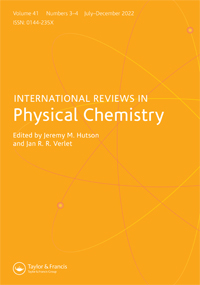通过光脱离棱镜探测暂时阴离子的超快动力学
IF 2.5
2区 化学
Q3 CHEMISTRY, PHYSICAL
引用次数: 36
摘要
综述了近年来频率分辨、角度分辨和时间分辨光电子成像(FAT-PI)技术在开壳阴离子共振动力学研究中的应用。概述了该方法的基本原理及其实验实现。然后考虑了一些自由基醌阴离子的动力学。首先,我们展示了对苯醌的频率和角度分辨光电子成像如何提供共振动力学的指纹,然后时间分辨光电子成像如何对共振的弛豫动力学产生深入的机制洞察。讨论了对醌电子载体的化学取代对共振动力学的影响。增加共轭导致共振衰减到自由基阴离子基态的能力大大增强。利用时间分辨光电子能谱分析表明,阴离子的束缚价态有利于动力学。与对苯醌相比,给电子的甲氧基的加入导致进入基态的能力降低。时间分辨动力学和计算都为这些观察提供了理论基础。我们考虑了FAT-PI的优点和局限性以及它与二维电子能谱的互补性。本文章由计算机程序翻译,如有差异,请以英文原文为准。
Ultrafast dynamics of temporary anions probed through the prism of photodetachment
The recently developed method of frequency-, angle-, and time-resolved photoelectron imaging (FAT-PI) applied to the study of the dynamics of resonances of open-shell anions is reviewed. The basic principles of the method and its experimental realisation are outlined. The dynamics of a number of radical quinone anions is then considered. Firstly, we show for para-benzoquinone how frequency- and angle-resolved photoelectron imaging provides finger-prints of the dynamics of resonances and then how time-resolved photoelectron imaging yields deep mechanistic insight into the relaxation dynamics of the resonances. The effect of chemical substitutions of the para-quinone electrophore on the dynamics of resonances is discussed. Increasing the conjugation leads to a greatly enhanced ability for resonances to decay to the ground electronic state of the radical anion. Using time-resolved photoelectron spectroscopy, it is shown that the dynamics are facilitated by a bound valence state of the anion. The addition of electron donating methoxy groups leads to a reduced ability to access the ground state compared to para-benzoquinone. Both time-resolved dynamics and calculations provide a rationale for these observations. We consider the benefits and limitations of FAT-PI and its complementarity to 2D electron spectroscopy.
求助全文
通过发布文献求助,成功后即可免费获取论文全文。
去求助
来源期刊
CiteScore
14.20
自引率
1.60%
发文量
5
审稿时长
1 months
期刊介绍:
International Reviews in Physical Chemistry publishes review articles describing frontier research areas in physical chemistry. Internationally renowned scientists describe their own research in the wider context of the field. The articles are of interest not only to specialists but also to those wishing to read general and authoritative accounts of recent developments in physical chemistry, chemical physics and theoretical chemistry. The journal appeals to research workers, lecturers and research students alike.

 求助内容:
求助内容: 应助结果提醒方式:
应助结果提醒方式:


